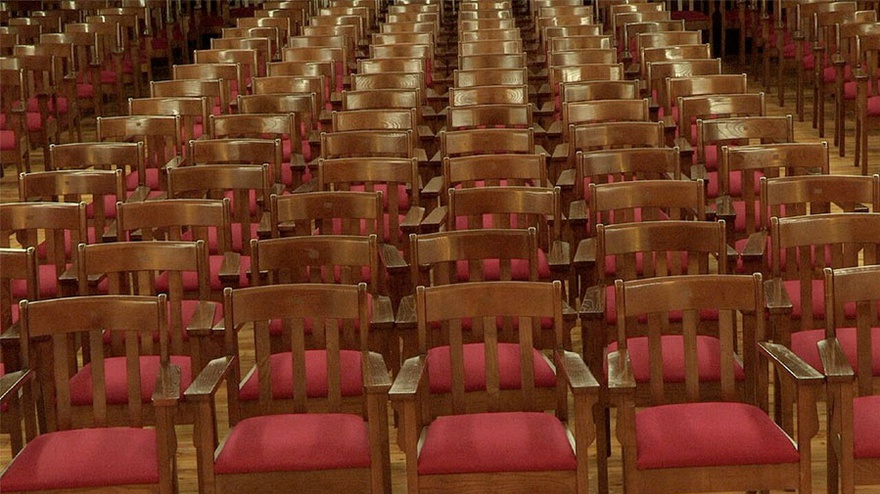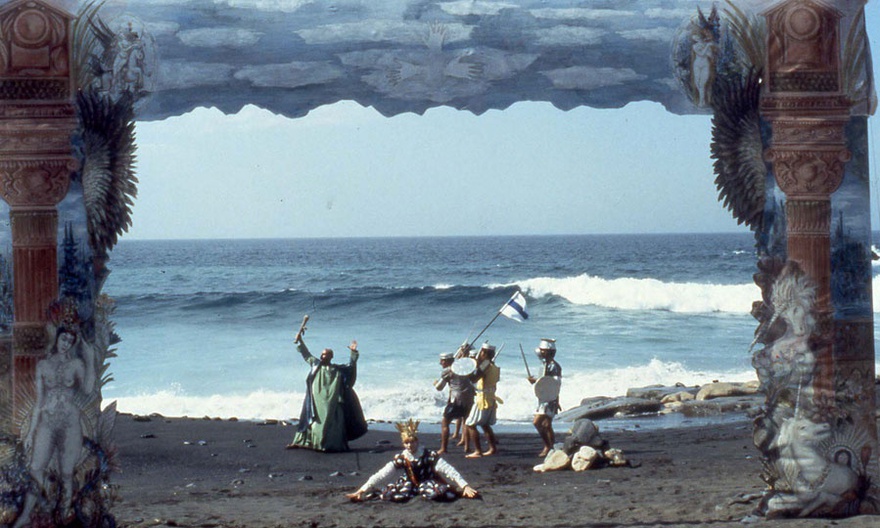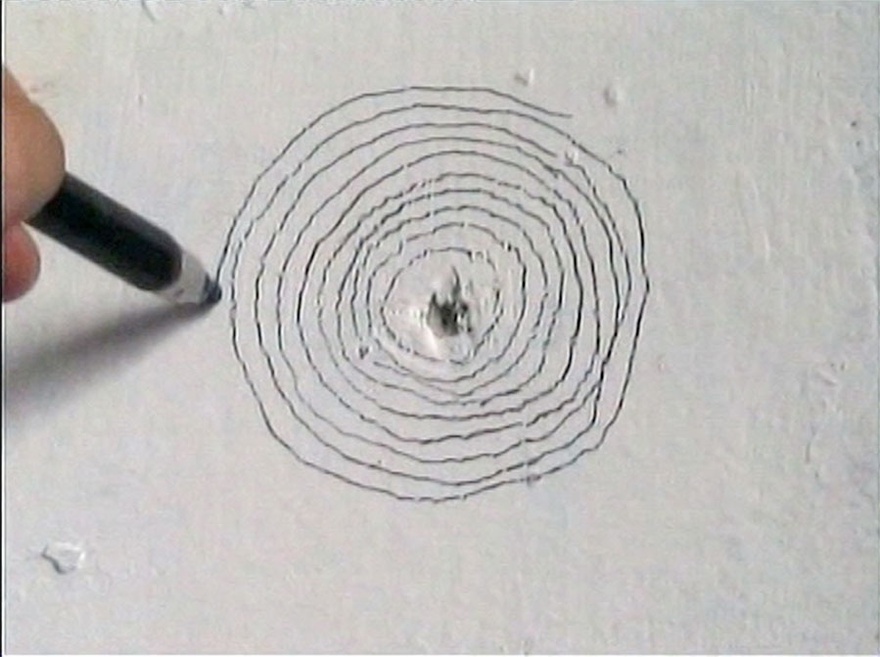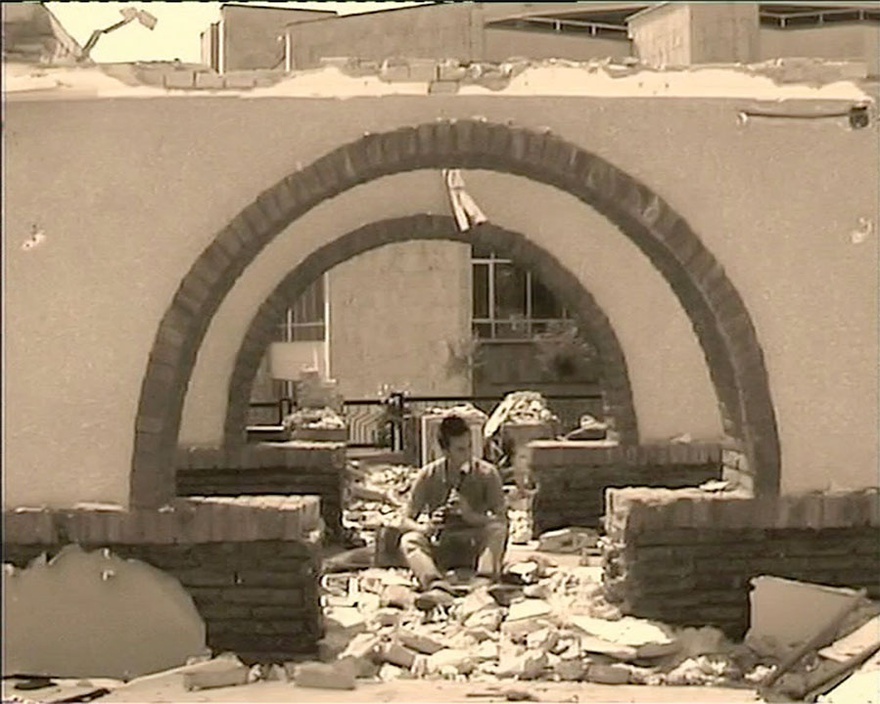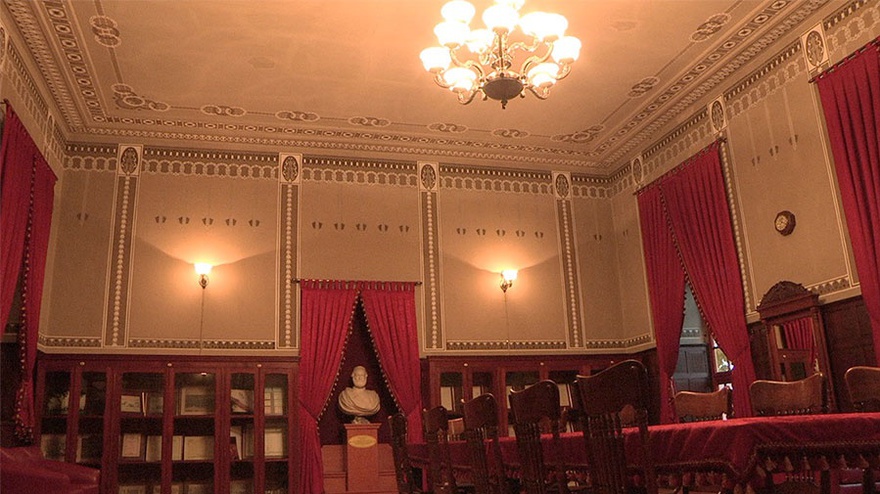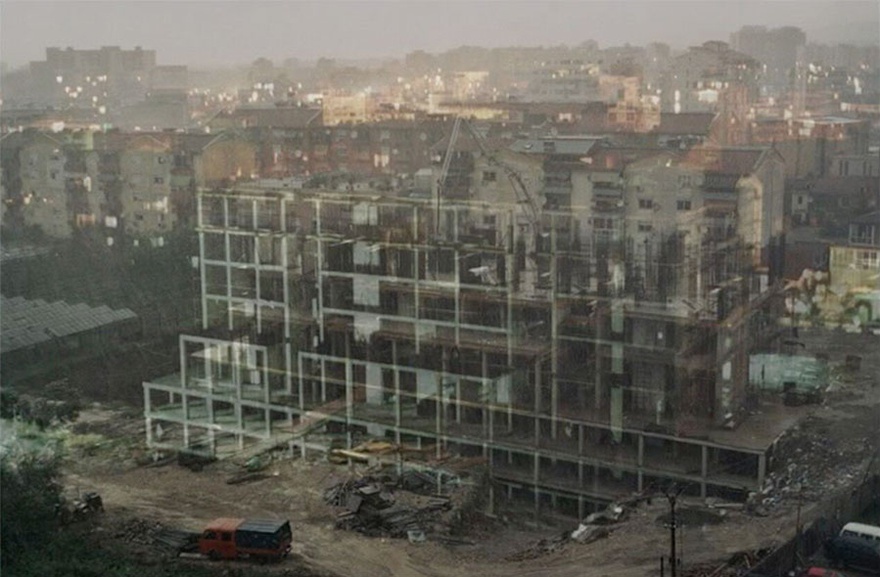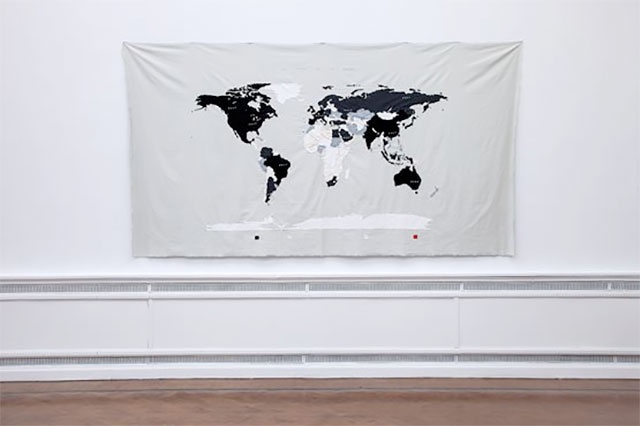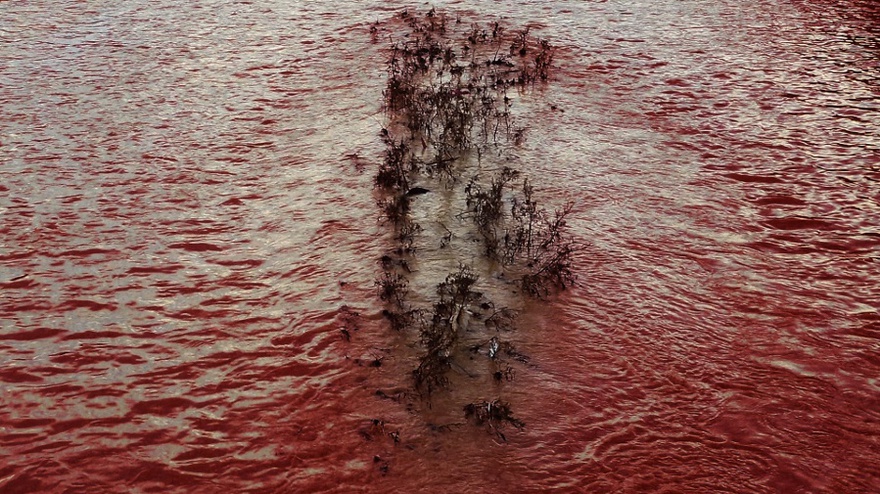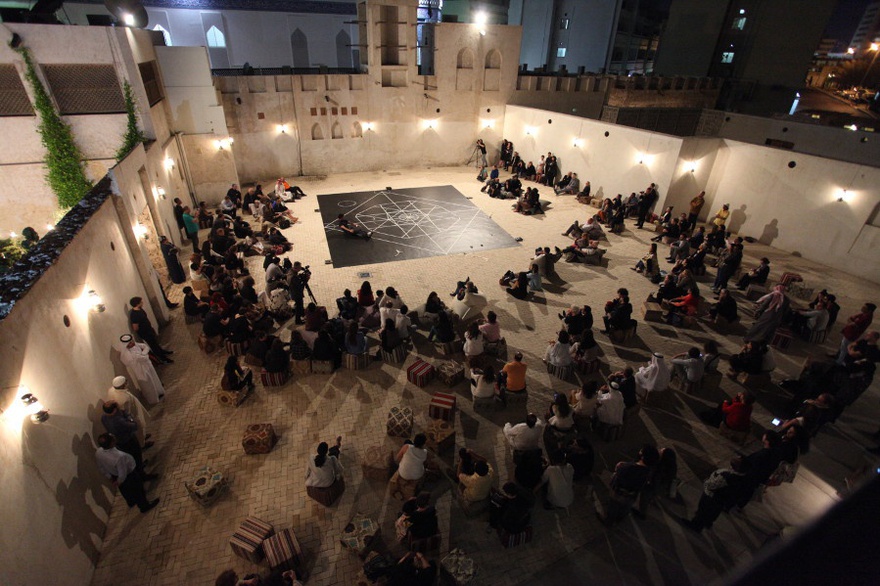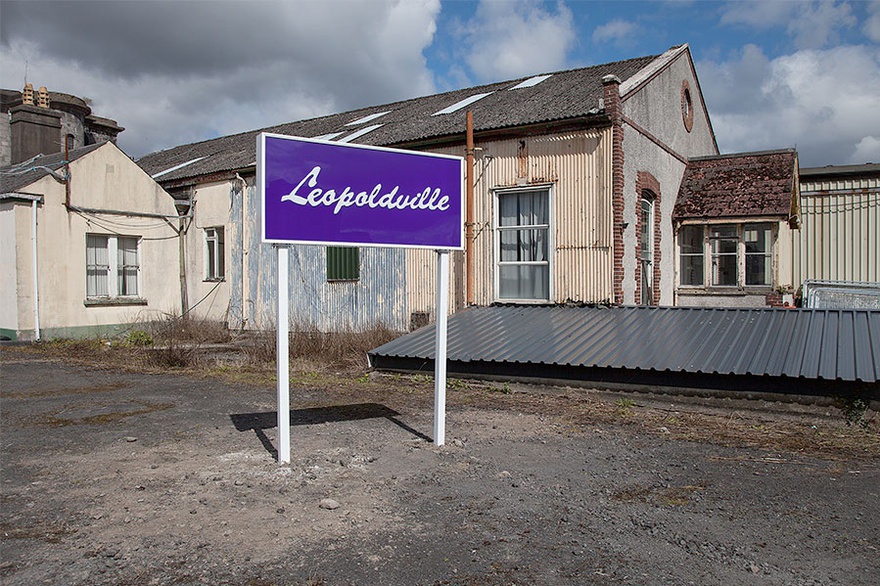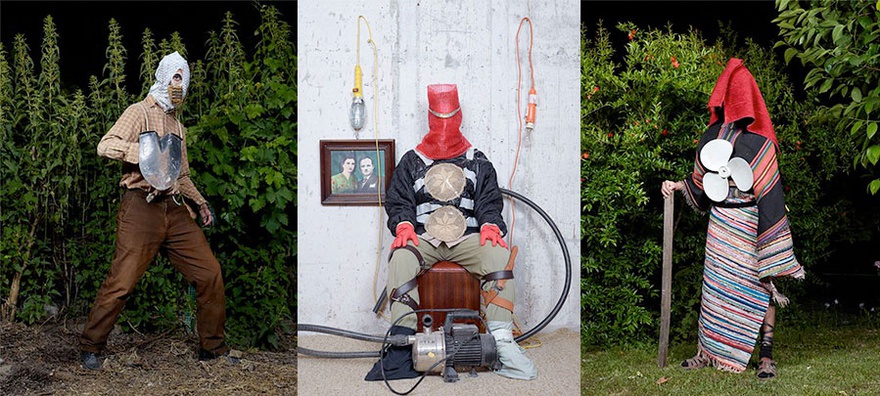Essays
Now Where?
On Navigating Without a Compass
'To every equation, to every formula in the surface world, there is a corresponding curve or mass.… And if these masses are not evident in our world, on the surface,then it's inescapable: they must have their own entire world there, beyond the surface.' [1]
– Yevgeny Zamyatin
This essay is not about the politics of terminology as much as it is about the histories to which regional terminologies are bound, and the processes that occur in and around their making. The intention is not to re-enforce the application of these terms, nor is it about re-defining the borders to which they extend. Rather, the idea is to consider the dynamics inscribed into words that define certain geographies so as to understand what is at work when they are deployed, bearing in mind Walter D. Mignolo's assertion that 'geopolitical namings and mappings are fictions'.[2] Core to this approach is the position that all words are common resources manifested as abstract spaces: sites of negotiation whose definitions are dependent on all stakeholders with a vested interest in their meaning.[3]
Geographical remits, and the terms associated with them, have become a standard method of curating large-scale exhibitions that often (wittingly or not) act as platforms for international diplomacy, sometimes reducing artists, curators, and writers (purposefully or otherwise) to the role of ambassadors expected to stand in as representatives of a cultural identity, either as part of a regional or national framing, or to complete a 'global picture'.[4] Looking at how these frameworks have been used in the art world in relation to their use in the economic sphere offers some insight into the geopolitical processes taking place through certain geographical framings and the words associated with them, particularly when considering the politics – and economics – of soft power, to which art so often aligns. This is especially true when taking into account the historical processes that have brought certain geographical nouns into being.
Take 'Middle East', a neologism that emerged[5] 'from the imperatives of late-nineteenth century diplomacy and strategy',[6] when there was a western need to define the region between the Far East (China) and the Near East (Turkey) for the purposes of colonial expansion.[7]) In its early inception, the term encapsulated the Arabian Gulf, expanding to incorporate Iraq, the eastern coast of Arabia, Afghanistan and Tibet.[8] After World War II, Winston Churchill redefined the territory to exclude Afghanistan and Tibet, and incorporated the Suez Canal, Sinai, the Arabian Peninsula, and the newly created states of Iraq, Palestine, and Trans-Jordan.[9] In its evolution, the Middle East's reach has included everywhere between the Mediterranean and the Indian Ocean, depending on the political and economic stakes involved.[10] The decline of the Ottoman Empire was a key factor in how the Middle East was physically defined – the result of a hasty division of the empire's former territories by the allied powers during, and after, World War I.[11] As Karl E. Meyer writes, the new states created at this time were 'less nations than swirling eddies of discontented peoples', leading one commentator to observe: 'They are making a breeding place for future war.' [12] The impact of these events extended well beyond the Middle East, North Africa, and the Mediterranean, too. Consider the breakdown of the former Yugoslavia in the early 1990s as a result of ethnic conflict. Established in 1918 out of Ottoman and Austro-Hungarian territory, Arjun Appadurai has noted how impossible it is to imagine Yugoslavia's collapse 'without the peculiar state structures into which these peoples were placed after World War I, in the wake of the collapse of the Habsburg, Ottoman and Russian empires.'[13]
Writing in 1993, post-Gulf War and in the aftermath of the Yugoslav breakup, Appadurai observed how, 'almost a half century after independence was achieved for many … "new" nations', that 'the nation form [was] under attack' – a form he called an 'ideological alibi of the territorial state' and 'the last refuge of ethnic totalitarianism', whose 'discourses have been shown to be deeply implicated' in those 'of colonialism'.[14] These words resonate in today, as a resurgence in nationalism echoes the genocidal impulses surrounding nation-building during the twentieth century – a time when, as Mark Levene wrote, a global system of nation-states was established on violent terms after the collapse of various empires.[15] This violence had to do with what Appadurai describes as the modern nation-state's 'preoccupation with the control, classification and surveillance of its subjects', which 'has often created, revitalized or fractured ethnic identities that were previously fluid, negotiable or nascent.'[16] Such fluidity is often mentioned in relation to the Ottoman Empire, which incorporated an array of ethnic groups within its sphere of influence so that they not only co-existed, but also overlapped. As Aron Rodrigue elaborates, 'There were Turkish-speaking Greeks, Arabic-speaking Jews, Latino-speaking Jews, Armenians only fluent in Turkish and not in Armenian.' [17] But these multicultural configurations were far from harmonious, nor were they always consensual, or devoid of bloodshed.
This contradictory Ottoman legacy – of being both an empire and global melting pot at once – was was invoked in a 2016 exhibition at Izolyatsia in Kyiv: art centre exiled from the Donbas region in 2014 when a pro-Russian separatist militia, declaring the 'People's Republic of Donetsk', stormed its premises. Curated by Cathryn Drake, The Presence of Absence, or the Catastrophe Theory, proposed a comparative study of three nation-states formerly bound by the Ottoman Empire – Turkey, Albania, and Greece – through the work of three artists whose work deals with the complexity of their respective contexts: Petros Efstathiadis, Ali Kazma, and Leonard Qylafi. As Drake writes, 'the diverse regions of Europe, the Balkans, and the Middle East', have 'taken vastly different directions guided by the vagaries of realpolitik and ethnic strife' since the Ottoman Empire's fall.[18] With Ukraine positioned between a post-Ottoman, post-Austro-Hungarian and post-Russian/Soviet cartography, the context of the exhibition was just as important as the works included. Drake took each history as a reflection of 'the enduring threads and ruptures that transcend the artificial constructs of political entities', including modern-day borders: 'a reality exemplified by the current European crisis and ongoing turmoil in the Middle East and Ukraine.'[19]
Current geopolitics cannot be divorced from those of the past, particularly when taking into account the historical period surrounding World War I, which saw various territories re-defined in the wake of imperial collapse.[20] Back then, the British Empire was concerned with keeping trade routes and trading posts under British control while opening up new ones in order to support an expansive economy, whose survival was predicated as much on international trade as it was on military strength. Most modern em1pires had – and have – similar concerns: to consolidate power through whatever means necessary. As Edward Said observed, modern empires, like capitalism, have long been adept at 'constantly expanding' and being 'inexorably integrative' for that purpose.[21] 'Whether in Marx, or in conservative works like those by J. R. Seeley, or in modern analyses like those by D. K. Fieldhouse and C. C. Eldridge,' he wrote, 'one is made to see that the British empire integrated and fused things within it, and taken together it and other empires made the world one.'[22] Making the world 'one' through expansion and integration is ultimately an act of (violent) consolidation in which a territory is bound by an identity that is articulated not only through economics, trade and infrastructure, but also through culture, and an articulation of it through language. This binding is reflected in the regional terms that have been used by both the colonizers and the colonized of history in order to stake and preserve territorial claims. Consider what being Ottoman meant: belonging to a geopolitical brand that incorporated different cultures into a single identity, and which even expelled certain cultures in the name of that identity (as was arguably the case with the Armenian genocide). It could be posited that the nation-state is a distillation of this idea – a form that bears the residue of the imperial histories out of which it emerged, where a single word, for example 'China', can come to define a complex community. (China is made up of over fifty ethnic groups, who did – and do – not all consent to being incorporated into the country's borders.)
This adds another dimension to the contemporary moment, when the world is being reshaped by an amalgam of neo-imperial and neo-national forces. With the collapse of some nation states, Iraq and Syria being two tragic examples, we have also seen the metamorphosis of others into a blend of history's formations. Take Russia, now re-asserting claims over the former Soviet Union, with the state activating its diaspora in support of its cause. (In 2014, the year the Crimea was annexed, parliamentary elections in Latvia saw a pro-Russia party take the largest share of the vote.[23]) These are interesting dynamics when taking into account a 2014 New Scientist editorial that described ISIS as a 'postmodern network' in a world 'after the nation state'.[24] In the same editorial, Russia's actions in eastern Ukraine, 'supposedly intended to protect Russian speakers', were described as 'a transnational act in itself' rather than one of neo-nationalism, or neo-imperialism.[25]
Undeniably problematic, this contemporary transnationalism recalls Appadurai's concept of the diasporic public sphere, which operates beyond the confines of a defined territory through a transnational network. It is in this diasporic condition that Appadurai saw the surges of a post-national order, and in one 1993 essay, he imagined how 'bounded territories could give way to diasporic networks, nations to trans-nations, and patriotism itself could become plural, serial, contextual and mobile'.[26] In that text, Appadurai considers how the United States might act as a model for a post-national space: 'one territorial locus (among others) for a cross-hatching of diasporic communities.'[27]
Some twenty years later, this vision of a post-nationalist space, or future transnationalism, has problematically aligned with the methods through which modern empires consolidated – and are consolidating – their borders and populations. It is a vision – and contradiction – that also aligns with processes unfolding within the global art world and the economic sphere, as reflected in the development of certain geographic and geopolitical terms that are being used in both realms as markers of cultural and political systems and their associated identities. Consider 'neoliberalism' or 'globalization' for instance: descriptors of what is often understood as a single political and economic project, often connected with forces of neocolonial expansion and exploitation, but which represent a complex set of regulated and unregulated processes undertaken – privately or otherwise – by individuals, corporations, institutions and governing bodies (to name but a few entities) that mediate the practice and application of both concepts in real time and not necessarily in alignment across the world.
***
In the twenty-first-century age of corporate empire, the term 'Middle East' has developed further. More recently, it has combined with 'North Africa' and 'South Asia' to create the acronym MENASA, which the financial community seems to have coined in the mid-2000s to define a rapidly developing region while bolstering relations within it.[28] The global management-consulting firm McKinsey takes MENASA as a single economic bloc, acknowledging connections that 'date back thousands of years'.[29 Global investment firm Abraaj Group, however, considers South Asia separately,[30] while taking MENASA as one holistic space in the realm of culture, as evidenced by the Group's art prize, launched in 2008 with Art Dubai to award artists from within it.
Founded in 2007, Art Dubai is an art fair firmly located within the MENASA's geography while not limited to it. The 2017 edition, for example, was described as the most globally diverse art fair in the world, with 94 galleries from 43 countries, from Algeria to Uruguay. This scope suits the global outlook of Abraaj Group, whose remit beyond MENASA includes markets in Sub-Saharan Africa, Asia, Turkey and Central Asia, and Latin America: a region commonly known as the 'Global South'. There is of course an expansionist agenda embedded into such practices as those undertaken by both Abraaj Group and Art Dubai; but these agendas acknowledge the realities of the times. One 2011 Abraaj Capital document describes a 'multipolar, multi-stakeholder world' that has replaced 'the predictable world of yesterday, characterized by its bipolar nature and the iron curtain.'[31] In this shift from an old to a new world order, 'competing blocs', 'fixed alliances' and 'hard power' have been replaced with a 'new multilateralism' based on 'global networks' and 'soft power'.[32]
The art world as a global community is an expression of this new multilateralism, with the proliferation of art fairs and biennials in particular offering one mapping of its trans-global terrain through apparatuses that constitute its network.[33] In the case of Art Dubai, this is a state- and corporate-sponsored event that mediates the socio-cultural and geopolitical forces of the global, regional, and national through a market-based cultural platform. Here, the acronym MENASA functions as 'a catalyst for integration', to quote Reema Salha Fadda: 'a strategy that integrates artists from regions occupying a more "peripheral" position into the global art economy' [34] while establishing Art Dubai as a centre for such integration to occur.[35] (A tactic that could be equated with Abraaj's role as an investment firm working in markets throughout the so-called Global South.) This logic was reflected in Art Dubai's recently discontinued Marker sector, which showcased underrepresented regions from beyond the MENASA.[36]
One could play devil's advocate here by posturing that this integrative and expansive approach is fundamentally flawed, in that there remains a centre of representation to which marginalised or 'peripheral' cultures and regions must aspire. Consider Artsy's numerical breakdown of representation by 'Race and Ethnicity' at the 2017 Venice Biennale.[37] Figures appear like a pyramid scheme, with '57% white' at the top of the list and '1% First Nations' at the bottom, recalling Wu Chin-Tao's description of the global art world's 'basic structure' as 'concentric and hierarchical...'[38] This centralized structure seems inscribed into such large-scale, international art events like the Venice Biennale, which emerged at a time when European nationalism was intrinsically tied with European imperialism, and World's Fairs acted as commerical and political platforms predicated on producing the nationalist-imperialist citizen of a modern world empire. Take London's 1851 Great Exhibition of the Works and Industry of All Nations: a World's Fair 'of all nations' that demonstrated 'a pronounced exhibtionary drive to strip Non-European communities of cultural and historical significance', so that such communities 'might be easily and profitably assimilated into a global' – read: British – 'economy'.[39]
Today, to quote Suhail Malik and Andrea Philips, art remains 'a "source of legitimacy" for empire-making allied to capitalization…'.[41] Consider the 'inexorably integrative' and 'constantly expanding' art market, with the Swiss fair Art Basel, which operates on three continents (in Basel, Miami and Hong Kong), recently described (rightly or wrongly) as a colonizing force[40] – not unlike Gagosian Gallery, with its empire of offices and galleries in Athens, Beverly Hills, Geneva, Hong Kong, London, New York, Paris, San Francisco and Rome.
But while the art world does operate as a propagator of soft power and the politics that are debated therein, it is also a critic of it, despite its connection to the history of empire, the economic logics followed by global investment firms, and the politics of governments who regulate the behaviours of art and finance within their sovereign states.[42] This is especially clear in the case of post-colonial regions like the Gulf, where, as Reema Salha Fadda writes, institutions support forms of soft power that not only serve 'to integrate art from within the [Middle East] (where colonial frameworks are still ongoing and where neoliberalism has only further fragmented the region)', 'but also to form connections with the world at large'.[43] There is a decolonial project inscribed into these endeavours, with the Sharjah Art Foundation being particularly active in creating the conditions for such connection to form in order to decentre the art world's western-centrism. At the 2012 March Meeting, Salah Hassan referred to the Foundation's MENASA position, describing its institutional model as one that 'shied away from the focus on spectacle and grand schemes in pursuit of western recognition and global legitimation' by concentrating on creating 'more engagement with artists locally and globally in a balanced manner that will benefit the regional art scene in the long term.'[44] A year later, this investment was broadened in Re:Emerge – Towards a New Cultural Cartography: the 2013 Sharjah Biennial curated by Yuko Hasegawa, who cited Anders Gunther Frank's 1998 book ReOrient (which considers Eurocentrism as nothing more than a blip in world history) as a key reference.
The 2013 Sharjah Biennial expanded on the MENASA remit by locating Sharjah within the Global South: a name Arif Dirlik describes as being 'entangled in its implications with other terms that post-World War II modernization discourse and revolutionary movements generated to describe societies that seemed to face difficulties in achieving the economic and political goals of either capitalist or socialist modernity.'[45] The result was a realignment of Sharjah's position, linking the Biennial and its context to a geography formerly known as the Third World, coined in 1952 by Alfred Sauvy 'to distinguish the formerly colonized or neocolonized world from the modernizing worlds of capitalism and socialism'.[46] Towards the end of the 1960s, the Third World came 'to represent a revolutionary way out of the dilemmas presented by capitalism actually-existing socialism'.[47] Galvanized by Algeria's independence, the movement, as Dirlik recalls, 'seemed poised at the edge of history'.[48] But that edge became a borderline[49] when Northern manouevres severed any chance of a North-South conversation in the 1980s,[50] relegating the former Third World to the lower tiers of a global capitalist economy.[51]
By 2003, the Third World became known as the 'developing' South, defined by its economic and industrial separation from the 'developed' North.[52] That year, the UN announced a special day for South-South cooperation to remedy a 'gross imbalance between developed and developing countries', with one document imploring the South to follow the example of an affluent North 'built on strong and interactive webs of cooperation'.[53] Fast-forward to 2013, and the Sharjah Biennial's Southern focus offered a visual representation of this imperative by representing a decolonizing 'South' internally dealing with the contradictions and paradoxes of a twenty-first-century world. This position embodied, in many ways, an ongoing Third World struggle for a way through the binaries laid down by the geopolitics of the Cold War. Walter D. Mignolo and Caroline Levander in 2008 described this embodiment succinctly when they called the Global South 'the place of struggles between, on the one hand, the rhetoric of modernity and modernization together with the logic of coloniality and domination, and, on the other, the struggle for independent thought and decolonial freedom.'[54]
Of course, the 2013 Sharjah Biennial's use of the term Global South also reflected trends within the economic sphere, as art's activities so often do. According to one UN report, 'Between 1996 and 2009, South-South trade grew, on average, 12 per cent per year (50 per cent faster than North-South trade),' and in 2011 accounted for 20 per cent of global trade.[55] Reflecting on this growth, the term appeared in 248 publications in the humanities and social sciences in 2013 (compared to just 19 in 2004).[56] That year, China launched the One Belt, One Road (OBOR) policy, a development strategy centred on reviving Silk Road routes on land and sea, and described as having 'the potential to be perhaps the world's largest platform for regional collaboration'[57] with the policy's scope covering some '65 percent of the world's population, about one-third of the world's GDP, and about a quarter of all the goods and services the world moves.'[58] OBOR is representative of a strategy of 'open regionalism' that China has been pursuing in the Global South through the 'creation of regional business forums for Africa, the Arab World, and Latin America.'[59] The idea is to create a transnational network based on economics and trade rather than culture or ideology.
China's approach appears decolonial if not post-western, despite the fact that such an economic project firmly places China at the centre of the region it is attempting to network through its OBOR initiative.[60] It also points to how the South as a concept has changed in recent years as various nation-states that were once included in its remit have shed post-war positions for neo-global futures.[61] The first G20 summit in 2008 offered some insight into how much North-South and South-South dynamics have changed, with 'official development assistance' contributions from China exceeding those from countries located in the so-called North, including Canada and Australia.[62] Today, as Dirlik observes, 'the geographies of development have been reconfigured, calling into question not only the earlier Three Worlds, but the viability of the North/South distinction. Presently, the boundaries between the two are crisscrossed by networks of various kinds, many of them economic, thus relocating some of the South in the North and vice versa.'[63]
What follows is the argument that the divisions laid down by the past no longer stand, and neither do the terms that represent them. In 2016, the World Bank even stopped distinguishing between 'developed' and 'developing' countries in the presentation of its data: a clear indicator of the implausibility of continuing a discourse along 'Northern' and 'Southern' lines.[64] 'The main issue is that there is just so much heterogeneity between Malawi and Malaysia for both to be classified in the same group-Malaysia is more like the US than Malawi,' Umar Serajuddin, a senior economist in the World Bank's statistics office, explained. 'When we lump disparate countries together in the same group, it isn't really useful.'[65] The same could be said against the use of the term Global South, the Middle East, and geopolitical naming in general, even if this argument is a provocation. There are, after all, arguments for naming, too, especially if undertaken as a point of resistance to pre-existing narratives. Abraaj Group's insistence on calling focus markets 'growth markets', for example, is to dispel the myth of 'risky emerging markets' – what chief executive Arif Naqvi calls a universally practiced hypocrisy.[66] In this case, the decentring of colonial dynamics is embedded into the assertion and definition of regional terms that are being put forward by post-colonial, albeit capitalist, subjects: a reversal of the legacy ingrained into 'Middle East' as an imposed colonial term, and an honouring of the Third World liberation movement's assertion that economic strength is crucial in asserting political positions.[67]
Yet, while various terms are being deconstructed and reasserted in both the cultural and economic sectors, viable alternatives have yet to emerge when it comes to finding new ways to articulate the world, its complexities, and its burgeoning politics. Or perhaps the third way proposed by the Third World remains unresolved. Today, as curator Xiaoyu Weng has pointed out, China, like many nation states, is sitting on a paradox – embracing 'the idea of a global community and the new free-floating individualism it engenders' while struggling 'to reinstate the very national borders and internal formsof control that global trade and multinational corporations tend to blur or erase'.[68] For Weng, 'to grasp both sides of this paradox at once' is 'what the present demands – and China is hardly alone in inhabiting it.'[69] In this globalized age, histories have become too intertwined to remain separated in what is essentially a globalized modernity,[70] leading writer Chan Koonchung to wonder if 'only a complicated cocktail of modern and global perspectives could more readily explain present-day reality.'[71]
China seems aware of this fact, if its foreign policy is anything to go by. But even this position links to the imperializing politics of the past, just as the global initiatives taken by cultural and financial institutions alike should not be considered innocent of the contradictory politics that are so often associated with geopolitical namings and mappings. Consider the slogan for the 2008 Beijing Olympics Games, which offers an insight into an aspiration that has manifested at various points in the world, and in various forms, throughout history, by a number of imperial powers: 'One World, One Dream'. The phrasing is both transparent and problematic when considering how the concept of a global 'oneness' has been co-opted for various interests, from the national to the corporate. The art world can also fall in line with this 'one world' logic. Yet, how this unfolds is ambiguous, given art's association with state and corporate interests and its tendency to at once uphold and critique them.
***
In thinking about these integrated times, two exhibitions in 2016 sought to destabilize the neat divisions through which the world has been understood. Koyo Kouoh's Eva International, Still (the) Barbarians, performed a destabilization of the North-South binary by pulling the post-colonial legacies and discourses of the South right into the heart of the North through the identification of Ireland, a member of the European Union, as the first post-colonial nation. In so doing, Kouoh invoked Appadurai's call 'To widen the sense of what counts as discourse' by demanding a 'widening of the sphere of the postcolony' in order 'to extend it beyond the geographical spaces of' what we have come to understand as 'the ex-colonial world'.[72]
Similarly, The Time is Out of Joint, curated by Tarek Abou El Fetouh and organized by the Sharjah Art Foundation in collaboration with the Asia Culture Center in Gwangju, was a group show that challenged fixed notions of place and time by taking two exhibition histories and one future conference into a single conceptual frame: the First Arab Art Biennale in Baghdad (1974), the China/Avant-Garde exhibition in Beijing (1989), and the future Equator Conference in Yogyakarta (2022). Taking on the concept introduced by Andalusian philosopher Ibn Arabi, in which time is considered as fluid space and space as fluid time, The Time is Out of Joint challenged the common use of regional frameworks in large-scale exhibitions by blurring and blending global time and space.
For Abou El Fetouh, Beijing in 1989 is equivalent to Egypt in 2011. The curator points to two images to support this claim: a man standing in front of a PRC tank during the Tiananmen Square protests in 1989, and a 2011 photo of an Egyptian man standing in front of a police tank. These image, the curator discovered, also connected with a photograph from the 1984 Democratic Uprising in Gwangju of a Korean man holding a flag in exactly the same way the protestor in Egypt was photographed in 2011. Referring to Judith Butler's essay, 'Bodies in Alliance and the Politics of the Street', in which Butler sees the 2011 Tahrir Square demonstrations in Egypt as both an active moment that created a space of equality and a performative stage that expanded to include people from all over the world, El Fetouh finds a common thread not only between past movements, but in the wave of global protests that were sparked in Tunisia in December 2010. In conversation, he notes: 'people entered into this collective body and began performing a space of equality in front of others: and this is why the other Arab revolutions started, and Occupy happened, and so on.'[73]
El Fetouh's cosmopolitan position transcends regional divides by reflecting on historical and contemporary ruptures understood both in parallel and in relation. It is an approach that embraces a sense of unity without offering a name, claim or brand other than an empathetic consideration of what it means to be a 'world citizen'. El Fetouh's approach recalls Kwame Appiah's rejection of the term 'west' and by association 'western civilization' in a lecture that recognizes the fact that, with some 'seven billion fellow humans' living 'on a small, warming planet' today, 'the cosmopolitan impulse that draws on our common humanity is no longer a luxury', but 'a necessity.'[74] It also reflects a prediction made in a 2009 Brookings Policy Brief that describes an increasingly globalized world made up of 'cross-border networks – economic and political, public and private, elite and grassroots, legitimate and illegitimate' – that will 'continue to grow' and as a result, weaken 'the traditional hold states have over the economic, financial, social and political actions of their citizens.' [75]
In this scenario, Appadurai's post-nationalist space or trans-nationalist diasporic public sphere applies once again, but this time as a counter-narrative to those proposed by various world powers seeking to dominate the map. The movements that have erupted worldwide since we entered the second millennium, from Tahrir to Hong Kong, reflect a certain dissonant unity when it comes to the crises plaguing the world as it stands, and a connection between the histories and systems that brought them into being. The contradictory relations between different manifestations of the global – from a corporate or colonial enterprise to a grassroots endeavour – demand attention if we are to think about how we might learn to bridge divides while similarly upholding and respecting them, so as to conceive of the global as a common site rather than a space that must be named, claimed, and 'unified'. To do so is to recognize a messy, complicated, and historic struggle that transcends borders and has no name, in which another world is already in the making.
[1] Yevgeny Zamyatin, WE, tr. Natasha Randall, (Vintage Books: London, 2007), p. 90.
[2] Walter D. Mignolo, 'The North of the South and the West of the East: A Provocation to the Question', Ibraaz, Platform 008, published online on 6 November 2014. http://www.ibraaz.org/essays/108
[3] I have written on the idea of words as commons in 'A Word in Common,' first published in Noiswere issue 11 in 2012, modified for publication on Notes on Metamodernism in 2014, and finally published in print and online as part of Naked Punch issue 18 in 2016.
[4] See Natasha Hoare's consideraton of the so-called geocultural exhibition in her Ibraaz Platform 010 essay, The Faustian Pact.
[5] The term is often attributed to American naval strategist Alfred Thayer Mahan, who used the term in a 1902 paper published in The National Review, despite there being instances of earlier use in the British India Office in the 1850s, according to Peter Beaumont, Gerald H Blake, J. Malcolm Wagstaff. See: The Middle East: A Geographical Study, (Wiley: 1988), p. 1. Other instances of the term prior to 1902 are mentioned by Clayton R. Koppes, who names General Sir Thomas Edward Gordon's use in 1900 in 'Captain Mahan, General Gordon, and the Origins of the Term "Middle East"', Middle Eastern Studies, Vol. 12, No. 1, 1976, p. 95. www.jstor.org/stable/4282584. And Daniel Foliard names Seth Low in an 1899 article in Dislocating the Orient: British Maps and the Making of the Middle East, 1854-1921 (University of Chicago Press: 2017), pp. 209-210.
[6] Clayton R. Koppes, 'Captain Mahan, General Gordon, and the Origins of the Term "Middle East"', Middle Eastern Studies, Vol. 12, No. 1, 1976, p. 95. www.jstor.org/stable/4282584
[7] Ibid.
[8] Sahar el-Nadi, 'Middle East of What?', The European Magazine, Debates: Democratization in the Middle East: The long story of a Label, 18 March 2012.
[9] Ibid.
[10] Koppes, p. 95.
[11] As encapsulated in the 1916 Sykes-Picot Agreement, the 1919 Treaty of Versailles, which established the mandate system, the 1920 Treaty of Sèvres, and the 1923 Treaty of Lausanne.
[12] Karl E. Meyer, Notebook; How the Middle East Was Invented, The New York Times, published 13 March 1991. http://www.nytimes.com/1991/03/13/opinion/editorial-notebook-how-the-middle-east-was-invented.html?mcubz=1
[13] Arjun Appadurai, 'The Heart of Whiteness', Callaloo, Vol. 16, No. 4, On 'Post-Colonial Discourse': A Special Issue (Autumn, 1993), p. 799.
[14] Ibid., p. 796.
[15] Mark Levene, 'Why Is the Twentieth Century the Century of Genocide?', Journal of World History, Vol. 11, No. 2 (Fall, 2000), p. 332.
[16] Appadurai, p. 799.
[17] Aron Rodrigue in conversation with Nancy Reynolds, SEHR, Vol. 5, No. 1: Contested Polities, updated online on 27 February 1996.
[18] Cathryn Drake, curatorial statement for The Presence of Absence, or the Catastrophe Theory, published on the Mousse Magazine website.
[19] Ibid.
[20] The Sykes-Picot Agreement is but one example of the manoeuvres that anticipated an Ottoman defeat – an agreement that Russia was initially a part of (they were promised eastern Turkey) until the 1917 Bolshevik Revolution put an end to Russian involvement, with the Soviets signing he Brest-Litovsk peace treaty with the Central Powers in 1918, effectively switching sides in the war, and essentially being excluded from 1919 Paris Peace Conference, during which some Allied Powers called for a military solution to deal with the 'Russian Problem'. See: Andrew J. Crozier, 'The Establishment of the Mandates System 1919–25: Some Problems Created by the Paris Peace Conference', Journal of Contemporary History, Vol. 14, No. 3 (Jul., 1979), pp. 483-513.
[21] Edward Said, Culture and Imperialism, (First Vintage Books Edition: 1994), p. 5.
[22] Ibid., p.6.
[23] See: Richard Milne, 'Pro-Russia party takes biggest vote share in Latvian election', Financial Times, 5 October 2014.
[24] Editorial, 'State of the Nation', The New Scientist, 6 September 2014, No.2985. http://www.newscientist.com/article/mg22329851.500-in-our-world-beyond-nations-the-future-is-medieval.html - .VEezdOfHMXw. I have cited this editorial in two other essays on Ibraaz, as a reflection of my ongoing interest in applying the concept to the context of the art world: 'Transition Times' (May 2015, http://www.ibraaz.org/essays/128), and 'A View from Afar' (October 2014, www.ibraaz.org/publications/15).
[25] Ibid.
[26] Appadurai, p. 806. I have cited the concept of the diasporic public sphere in two other essays on Ibraaz, as a reflection of my ongoing interest in applying the concept to the context of the art world: 'Transition Times' (May 2015, http://www.ibraaz.org/essays/128), and 'A View from Afar' (October 2014, www.ibraaz.org/publications/15).
[27] Appadurai, p. 804.
[28] Tom Speechley notes that Abraaj Capital coined the acronym in 'Infrastructure needs in the Middle East, North Africa and South Asia', in Infrastructure Finance: Trends and Techniques, ed. Henry A. Davis (Euromoney Books: 2008), p. 127.
[29] Kito de Boer, Chris Figee, Saeeda Jaffar, Daan Streumer, Perspective on the Middle East, North Africa, and South Asia (MENASA) region, published in 2008 by McKinsey&Company, July 2008.
[30] Speechley, 'Infrastructure needs in the Middle East, North Africa and South Asia'.
[31] 'Abraaj Capital's Approach to the Stakeholder Society: Reinventing the Shape of the Private Equity Model', June 2011. http://www.abraaj.com/wp-content/uploads/pdf/Abraaj_Capitals_Approach_to_the_Stakeholder_Society.pdf
[32] Colin I. Bradford and Johannes F. Linn Friday, 'Is the G-20 Summit a Step Toward a New Global Economic Order?' Brookings Policy Brief Series, 11 September, 2009
[33] In 2011, Art Vista counted 149 modern and contemporary art fairs and 22 biennials staged that year alone (http://www.artvista.de/pages/art-fair-and-biennial-statistics.html), and in 2016, Terry Smith counted 150 biennials in total that exist (See: 'Biennials: Four Fundamentals, Many Variations', Biennial Foundation Magazine, 7 December 2016. The number of art fairs counted on the Art Newspaper calendar list in 2015 was 269. See: Scott Reyburn, 'Art Fair Fatigue May Resolve Itself', The New York Times, 23 January 2015.
[34] As noted by my colleague Reema Salha Fadda in her editorial comments on this essay, made on 13 July 2017.
[35] I have written elsewhere on art fairs as apparatuses of security in the Foulcaudian sense, using Art Dubai as a case study. See: Between Dubai and Sharjah: Charting Global Discourse(s), Yishu: Journal of Contemporary Chinese Art, Jul/Aug2012, Vol. 11 Issue 4, p6.
[36] In 2017, this sector was discontinued, with fair director Myrna Ayad stating there was no longer a need for it, given the globalized nature of the main gallery floor, that year, as stated, with some 43 countries represented.
[37] Artsy Editorial, 'Venice Biennale Artists by the Numbers', 3 May 2017: https://www.artsy.net/article/artsy-editorial-venice-biennale-artists-numbers
[38] Wu also points out Okwui Enwezor's 2002 documenta 11, described as 'the most radically conceived event in the history of postcolonial art practice' that offered 'an unprecedented presence of artists from outside Europe and North America'. Wu observed 'nearly seventy-eight per cent of the exhibiting artists featured were living in North America or Europe'. Chin-Tao Wu, 'Biennials Without Borders?' Tate Papers, Issue 12. http://www.tate.org.uk/research/publications/tate-papers/12/biennials-without-borders#footnoteref7_toslpno
[39] As Paul Young writes: Aboriginal products were 'stripped of any cultural resonance' on the exhibition floor and 'offered up … as raw materials'. The China section, meanwhile, which had little to no participation from the Chinese state, and was met with derogatory responses. See: Paul Young, 'Mission Impossible: Globalization and the Great Exhibition', p.16, and Francesca Vanke, 'Degrees of Otherness: The Ottoman Empire and China at the Great Exhibition of 1851, p. 201, in Britain, the Empire, and the World at the Great Exhibition of 1851(eds. Jeffrey Auerbach and Peter H. Hoffenberg) (Ashgate Publishing Ltd: 2008).
[40] Alyssa Buffenstein, 'Art Cologne Director Thinks Art Basel's Expansion Is a "Form of Colonialism"', Artnet, 25 April 2017.
[41] Suhail Malik and Andrea Philips, 'tainted love: art's ethos and capitalization', in Contemporary Art and its Commercial Markets. A Report on Current Conditions and Future Scenarios, eds. Maria Lind and Olav Velthuis (Sternberg Press: Berlin, 2012): p.230.
[42] As my colleague Ala Younis noted in her editorial comments on this essay, made on 23 July 2017: 'There is another contradiction evident in the art world/market; while some projects expose who lives/is in the periphery, and thus people in precarious, poor, or under-represented conditions, these projects are sometimes put up for sale (thus ending up in the hands of the rich, or in institutions as acquisitions), or are shown in museums (taking into account the history of museums, and the complicated relationship between these histories and what museums do, represent, and so on). I mean to say that the art world is also a centralized body, and within its centre is conflicting practices/notions.'
[43] As noted by my colleague Reema Salha Fadda in her editorial comments on this essay, made on 13 July 2017.
[44] Salah Hassan, Keynote speech at the 2012 March Meeting at the Sharjah Art Foundation, 17–19 March 2012. See the publication dedicate to the event: Working with Artists and Audiences on Commissions and Residencies, March Meeting 2012, , ed. Anne Barlow (Sharjah Art Foundation: 2014), p. 36.
It is important to note here that the section following this endnote, which includes mention of the Sharjah Biennial, EVA International, and definitions and developments within the South not to mention the OBOR policy, were also cited in my introduction to a specially edited dossier in LEAP magazine's June issue, Non-Aligned Movements.
[45] Arif Dirlik, 'Global South: Predicament and Promise', The Global South, Vol. 1, No. 1 (Winter, 2007), pp. 12-13.
[46] Ibid., p. 13.
[47] Ibid., p. 14.
[48] Dirlik, p. 14.
[49] See: Vijay Prashad, 'Dream History of the Global South', Interface: a journal for and about social movements, Vol. 4, No. 1 pp. 43-53 (May 2012).
[50] See: Ronald E. Muller and Arthur L. Domike, 'Cancun's Meaning', The New York Times, 18 October 1981: http://www.nytimes.com/1981/10/18/opinion/cancun-s-meaning.html; Prashad, 'Dream History of the Global South', p. 48; and John Williamson, 'A Short History of the Washington Consensus', a paper commissioned by Fundación CIDOB for the conference 'From the Washington Consensus towards a new Global Governance', Barcelona, 24–25 September 2004.
[51] …in which national economic development no longer required the development of a nation as a whole, but only of those sectors that could benefit the global economy. See: Dirlik, p. 15.
[52] …with 'all the world's industrially developed countries (with the exception of Australia and New Zealand) lie to the north of its developing countries. See: United Nations Development Programme, 'Forging a Global South' in the United Nations Day for South-South Co-operation, 19 December 2004.
[53] Ibid.
[54] Caroline Levander and Walter Mignolo, 'Introduction: The Global South and World Dis/Order', Global South, Vol. 5, No. 1, (Spring 2011), p. 4.
[55] 'South-South Integration is Key to Rebalancing the Global Economy', United Nations Conference on Trade and Development Policy Briefs, no. 22, February 2011.
[56] Thomas Hylland Eriksen in 'What's Wrong with the Global North and the Global South?' published on the Global South Studies Center website. http://gssc.uni-koeln.de/node/454 Quoting: Heike Pagel, Karen Ranke, Fabian Hempel, and Jonas Köhler, 'The Use of the Concept "Global South" in Social Science & Humanities', presented at the symposium 'Globaler Süden / Global South: Kritische Perspektiven', Institut für Asien- & Afrikawissenschaften, Humboldt-Universität zu Berlin, 11 July 2014.
[57] Ibid.
[58] Kevin Sneader, quoted in 'China's One Belt, One Road: Will it reshape global trade?' a McKinsey Podcast recorded in May, featuring McKinsey senior partners Joe Ngai and Kevin Sneader speaking with editor at McKinsey Publishing, Cecilia Ma Zecha. Published online in July 2016.
[59] Alex E. Fernandez and Barbara Hogenboom, 'China's Growing Economic and Political Power: Effects on the Global South', The Asia-Pacific Journal | Japan Focus, Vol. 5, No. 12: 0, December 2007, p. 9.
[60] As Dirlik writes, such a consensus 'seeks in multilateral global relationships a new global order which is founded on economic relationships but also recognizes political and cultural difference, which recognizes differences in regional and national practices within a common global framework…' (Dirlik, p. 18.)
[61] As Arif Dirlik notes, the conception of the South 'may be significantly different in its composition and territorial spread' today compared to 'the South of the early 1970s, or the colonial South of the immediate post-World War period'. (Dirlik, p. 13.)
[62] Adolf Kloke-Lesch and Colin Gleichman, 'Global development beyond the North-South paradigm', G20 and Global Development, Thomas Fues / Peter Wolff (eds.), 2010: German Development Institute / Deutsches Institut für Entwicklungspolitik (DIE), p. 15.
[63] See: Dirlik, p. 15, and note: this point recalls Abraaj Group's argument that the weakest link in the world economy in 2008 was not in the so-called 'emerging' South, but in the heart of the 'developed' North. See: Naqvi quoted by Elizabeth MacBride in 'The Story Behind Abraaj Group's Stunning Rise In Global Private Equity', Forbes, published online on 4 November 2015.
[64] Tim Fernholz, 'The World Bank is eliminating the term "developing country" from its data vocabulary', Quartz, 17 May 2016.
[65] Ibid.
[66] As quoted by Elizabeth MacBride in 'The Story Behind Abraaj Group's Stunning Rise In Global Private Equity', Forbes, published online on 4 November 2015.
[67] As noted by Marcelino dos Santos, a founding member of FRELIMO for liberation of Mozambique, in an archival clip included in Naeem Mohaiemen's Two Meetings and a Funeral (2017), a three-channel video study of the Non-Aligned Movement first shown at documenta 14 in Kassel, 2017.
[68] Xiaoyu Weng, 'Counter-mythologies, or Tales of Our Time', in Tales of Our Time Exhibition Catalogue, (Guggenheim Museum Publications: New York, 2016), p. 19.
[69] Ibid.
[70] Chan Koonchung, 'Ambiguous Doublespeak: The Two Songs Sung Simultaneously by Jiangshu in Chinese Discourse', The Time is Out of Joint Exhibition Reader, Volume 1 (Sharjah Art Foundation, 2016), p. 59.
[71] Ibid.
[72] Appadurai, p. 796.
[73] Tarek Abou El Fetouh in conversation with Stephanie Bailey, Ibraaz, Platform 010, 6 May 2016: http://www.ibraaz.org/interviews/193.
[74] Kwame Appiah, 'There is no such thing as western civilization', The Guardian, 9 November 2016.
[75] Colin I. Bradford and Johannes F. Linn Friday, 'Is the G-20 Summit a Step Toward a New Global Economic Order?' Brookings Policy Brief Series, 11 September, 2009.

